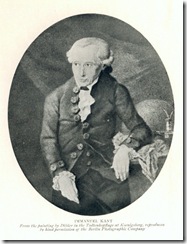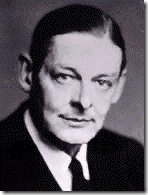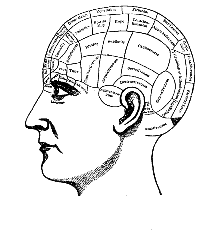
What does eighteenth century naval warfare have to do with life today? Nothing, as far as I can tell, yet one of the pleasures of reading Patrick O’Brian’s novels about Jack Aubrey and Stephen Maturin — one of the great portraits of male friendship in English literature — is the anachronistic affinities one finds between the bygone world of wood and canvas and quotidian modern life, thanks to Mr. O’Brian’s ingenuity.
Take, for instance, this passage from Master And Commander in which Jack, while at sea, is obliged to sign a legal document drafted by his predecessor, the previous captain of the sloop Sophie:
My Lord,
I am to beg you will be pleased to order a Court Martial to be held on Isaac Wilson (seaman) belonging to the Sloop I have the honour to Command for having committed the unnatural Crime of Sodomy on a Goat, in the Goathouse, on the evening of March 16th. I have the Honour to remain, my Lord, Your Lordship’s most obedient very humble servant ….
Like the modern reader, Jack is not pleased with the rules and procedures one must comply with in the course of fulfilling one’s duties. For his friend, Stephen, the matter is simply one that inspires perplexity.
‘It is odd how the law always harps upon the unnaturalness of sodomy,’ observed Stephen. ‘Though I know at least two judges who are paederasts; and of course barristers … What will happen to him?’
‘Oh, he’ll be hanged. Run up at the yard-arm, and boats attending from every ship in the fleet.’
‘That seems a little extreme.’
‘Of course it is. Oh, what an infernal bore — witnesses going over to the flagship by the dozen, days lost … the Sophie a laughing-stock. Why will they report these things? The goat must be slaughtered — that’s but fair — and it shall be served out to the mess that informed on him.’
‘Could you not set them both ashore — on separate shores, if you have strong feelings on the moral issue — and sail quietly away?’
‘Well,’ said Jack, whose anger had died down. ‘Perhaps there is something in what you propose. A dish of tea? You take milk, sir?’
‘Goat’s milk, sir?’
‘Why, I suppose it is.’
‘Perhaps without milk, then, if you please.’
The connection to be found between this passage and today’s headlines is no doubt as obvious to you as it is to me, reader. The notion of contamination which runs thematically through this brief anecdote is a clear analog for the theory of memes. Terms such as "viral", often used to describe memes, reveal the epidemiological roots of memetic theory. While the vectors are different, the notion that the sin of seaman Isaac Wilson has somehow been transmitted to the hapless goat, for which reason the goat "must be slaughtered," mirrors the theory that ideas such as "freedom", "God", and "revolution" can be transmitted from person to person, carrying with them certain properties that will affect the behavior of the infected.
At the same time, this anecdote reveals one of the chief problems with memetic theory. The idea of memes depends on a peculiar notion about the identity of memes when they inhabit different hosts. But is this identity really something we can take for granted? Is the "freedom" meme really the same from person to person? What is missing from the meme theory is an acknowledgement of the inherent ambiguity of all ideas. One man’s meat is another man’s poison, after all.
For instance, what is the intent behind serving the slaughtered goat, the unwarranted victim of seaman Isaac Wilson’s wantonness, to the seamen who informed on him? Is it a reward for their dutifulness with regard to the Royal Navy or a punishment for their faithlessness with regard to their comrade? Is the intent to let them taste a bit of Mr. Wilson’s humiliation, or to fill their bellies with a rare treat?
Memetics seems to completely ignore the much more interesting phenomenon of the association of ideas — perhaps necessarily so, since while the affinity between various notions and concepts, the way one idea leads to another, depends on the malleability of thought, memetics depends on its immutability.
The point is brought across in Stephen Maturin’s aversion toward the goat’s milk. Why does he refuse the milk? Because, in his mind, he associates it with Mr. Wilson’s goat. One idea leads naturally to the other and the properties of Mr. Wilson’s crime are mysteriously transferred to the goat’s milk — an entirely different goat, certainly.
 Immanuel Kant (1724-1804), normally thought of as a dour man though a great philosopher, is duly famous within certain disreputable circles for inserting the goat’s milk meme into his seminal work, the Critique of Pure Reason, sometimes known as the First Critique. In Section III of the Second Part of the Doctrine of Elements, after he has explained the meaning of the term transcendental logic, and after he has assented to the traditional definition of truth as the agreement between knowledge and its object, Kant drops this witty passage:
Immanuel Kant (1724-1804), normally thought of as a dour man though a great philosopher, is duly famous within certain disreputable circles for inserting the goat’s milk meme into his seminal work, the Critique of Pure Reason, sometimes known as the First Critique. In Section III of the Second Part of the Doctrine of Elements, after he has explained the meaning of the term transcendental logic, and after he has assented to the traditional definition of truth as the agreement between knowledge and its object, Kant drops this witty passage:
To know what questions may reasonably be asked is already a great and necessary proof of sagacity and insight. For if a question is absurd in itself and calls for an answer where none is required, it not only brings shame on the propounder of the question, but may betray an incautious listener into absurd answers, thus presenting, as the ancients said, the ludicrous spectacle of one man milking a he-goat and the other holding a sieve underneath.
Kant alludes to the fact that this particular meme has classical antecedents, and indeed one can find it in Lucian’s (c. 125-180 AD) Life of Demonax (c. 70-170 AD). That particular version of the meme was later replicated in Erasmus’s (1466-1536) collection of Adages.
When [Demonax] saw a pair of philosophers, each as ignorant as the other, disputing together, one propounding absurd questions and the other giving crazy answers, entirely off the point: ‘Why friends,’ said he, ‘is not one of these fellows milking a he-goat and the other putting a sieve under it?’
To Polybius (c. 203-120 BC), in turn, is ascribed the following version of the trope:
But I fear that the well-known adage may apply to me unknown to myself: "Which is the greater simpleton, the man who milks a he-goat or he who holds a sieve to catch the milk?" For it may be said of me that by confuting in detail what is confessed to be a lie, and doing so at great length, I am behaving in a very similar manner. So I shall be told I entirely waste my time in speaking of this matter, unless indeed I wish to record dreams and take into serious consideration the visions of a man with his eyes open.
Erasmus ascribes this same variation to Diogenes of Sinope (c. 404-323 BC) (aka Diogenes the Cynic).
Another variation can be found in Boswell’s Life of Johnson, though in this case, we move from goats to bovines, and interestingly Samuel Johnson (1709-1784) is mocking the Scottish philosopher (1711-1776) whom Kant credited with waking him from his dogmatic slumber.
Hume, and other sceptical innovators, are vain men, and will gratify themselves at any expence. Truth will not afford sufficient food to their vanity; so they have betaken themselves to errour. Truth, Sir, is a cow that will yield such people no more milk, and so they are gone to milk the bull.
(I recommend that the curious reader not attempt googling on the phrase "milk the bull", since this seems to have taken on a different meaning in recent times. "Milk the he-goat", however, is quite safe for searching.)
An obvious question is raised by these variations on a meme. While they are obviously dependent on one another, and perhaps some sort of history can be traced showing how the trope has been transmitted over time from this thinker to that one, are they in fact the same meme? Do memes admit of variation, or must a meme always have the same form? In the latter case, are we then dealing with two memes, for instance the Polybius version and the Demonax version, with the Demonax variation later mutating into the Samuel Johnson version, or is it the case that each host (Demonax, Diogenes, Polybius, Erasmus, Johnson, Kant, O’Brian [1914-2000]) actually possesses a different meme altogether?
The rules by which a meme is transmitted from host to host is a central concern for memetics, and the problem of identity will remain a problem for it. More interesting, from my point of view, is the problem of similarity. What are the rules by which we associate certain ideas with other ideas? Why does Stephen Maturin associate goat’s milk with a seaman’s indiscretion, to the point that he will not drink the milk? How are we able to find a resemblance between these different variations on the he-goat anecdote, derived from different sources, to the point that we associate them all together?
In the First Critique, Kant raises a similar question about the character of experience. Why should it be that events happen in a certain sequence? Why do causes always precede their effects, instead of the other way around? For Kant — and for you too, perhaps, if you have read the Critique — this is a perplexing and ultimately uncanny feature of our experience of the external world. That events should happen in a certain sequence, and not in another, Kant calls Affinity (in philosophical jargon, it is known as the transcendental affinity of the manifold of intuition).
While Kant would not — for those interested, this is because according to Kant inner sense is not associated with a manifold –, we might ask the same question about the way in which one idea follows from another in the stream of consciousness. What are the rules by which, say, the idea of a madeline leads a man to think back on his childhood and wonder about the nature of remembrance? Like memes, the flow of ideas have a viral, irrational, and uncontrollable character to them. It is something like the way in which you get on the Internet to look up how to throw a cocktail party and end up, hours later, reading about cooking with monkey. Whereas memes are objects of a germinal science about how ideas are transmitted between people, shouldn’t there also be a science concerned with the logic by which ideas are linked together within the same person?
But perhaps this is not possible, since a universal logic of how ideas follow upon one another depends on all people being basically the same, and this cannot be guaranteed. Certain people find affinities and make connections that others simply do not. The point is well illustrated in T. S. Elliot’s (1888-1965) play The Cocktail Party — again, contamination is a central theme, here. The setting is simple enough. Edward and Lavinia host a cocktail party, and Alex, a guest, explains current affairs in colonial Africa.

Edward: But how do monkeys cause unrest?
Alex: To begin with, the monkeys are very destructive …
Julia: You don’t need to tell me that monkeys are destructive. I shall never forget Mary Mallington’s monkey, The horrid little beast — stole my ticket to mentone and I had to travel in a very slow train and in a couchette. She was very angry when I told her the creature ought to be destroyed.
Lavinia: But can’t they exterminate these monkeys if they are a pest?
Alex: Unfortunately, the majority of the natives are heathen: they hold these monkeys in particular veneration and do not want them killed. So they blame the Government for the damage that the monkeys do.
Edward: That seems unreasonable.
Alex: it is unreasonable, but characteristic. And that’s not the worst of it. Some of the tribes are Christian converts, and, naturally, take a different view. They trap the monkeys. And they eat them. The young monkeys are extremely palatable: I’ve cooked them myself …
Edward: And did anybody eat them when you cooked them?
Alex: Oh yes, indeed. I invented for the natives several new recipes. But you see, what with eating the monkeys and what with protecting their crops from the monkeys the Christian natives prosper exceedingly: and that creates friction between them and the others. And that’s the real problem. I hope I’m not boring you?
Edward: No indeed: we are anxious to learn the solution.
Alex: I’m not sure that there is any solution. But even this does not bring us to the heart of the matter. There are also foreign agitators, stirring up trouble …
Lavinia: Why don’t you expel them?
Alex: They are citizens of a friendly neighboring state which we have just recognised. You see, Lavinia, there are very deep waters.
Edward: And the agitators; how do they agitate?
Alex: By convincing the heathen that the slaughter of monkeys has put a curse on them which can only be removed by slaughtering the Christians. They have even been persuading some of the converts — who, after all, prefer not to be slaughtered — to relapse into heathendom. So, instead of eating monkeys they are eating Christians.
Julia: Who have eaten monkeys.
Alex: The native is not, I fear, very logical.











